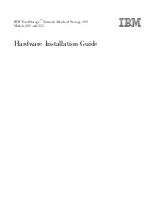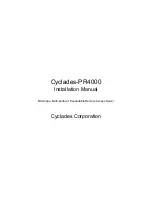
Issue 2.0
SV9100 Networking Manual
5-13
S
ECTION
6
DSP R
ESOURCE
C
ALCULATION
Voice over IP (NECi SIP, SIP stations, SIP trunks) requires DSP resources to be able
to convert from TDM
3
to IP technologies. DSPs (Digital Signal Processors) take a
TDM signal and convert to Realtime Transport Protocol (RTP) for transmission as
VoIP, and vice versa. Each IP to TDM conversion requires a DSP resource.
DSP resources are provided by the GPZ-IPLE It can be difficult to work out how
many DSP resources are required in an UNIVERGE SV9100 system, because:
not all IP Extensions/trunks are used at the same time
peer-to-peer calls do not use a DSP resource
GPZ-IPLE IP Addressing
The GPZ-IPLE requires two IP Addresses, one for Signaling (PRG 10-12-09), and
one for the DSP Resources (PRG 84-26-01).
When assigning the IP addresses to the GPZ-IPLE card, they must be in the same network
(subnet). If the CPU will be connected to the network it requires a separate IP address in a
different network (subnet). When an GPZ-IPLE card is attached to the CPU, using the CPU
NIC is no longer required. All connections that previously terminated to the CPU NIC card
can now be terminated to the GPZ-IPLE NIC. For example, PC PRO, Web Pro, and ACD all
terminate to the GPZ-IPLE NIC card when installed. Both the GPZ-IPLE and CPU NIC
share the same gateway assignment. The default gateway command in Program 10-12-03 is
used by both NICs, allowing only one device,
GPZ-IPLE or CPU, to route outside of its own
network.
The following chart shows the minimum and maximum number of IP addresses used
with different GPZ-IPLE card configurations.
3.
TDM = Time Division Multiplexing - traditional circuit-based telephony
Card
Minimum IP
Addresses
Maximum IP
Addresses
Notes
GPZ-IPLE
1
2
The number of DSP channels
depends on the VOIP license
loaded to GCD-CP10 up to 256.
Summary of Contents for Univerge SV9100
Page 1: ...Networking Manual A50 035910 004 AU Issue 2 0...
Page 20: ...xviii Table of Contents Issue 2 0...
Page 26: ...xxiv List of Figures Issue 2 0...
Page 33: ...Book 1 SV9100 K CCIS...
Page 49: ...Issue 2 0 1 16 General Information US Only Figure 1 15 Circuit Identification Codes CIC...
Page 53: ...Issue 2 0 1 20 General Information US Only...
Page 61: ...Issue 2 0 2 8 Hardware Installation US Only...
Page 195: ...Issue 2 0 4 116 Features and Specifications...
Page 242: ...Book 2 SV9100 IP Networking...
Page 256: ...Issue 2 0 2 12 IP Networking...
Page 312: ...Issue 2 0 4 48 Programming...
Page 376: ...Issue 2 0 6 30 SIP Trunking...
Page 391: ...Issue 2 0 7 14 H 323 Trunking...
Page 467: ...Issue 2 0 8 76 IP Multiline Station SIP...
Page 551: ...Issue 2 0 10 64 SV9100 NetLink Conditions None Feature Cross Reference None...
Page 567: ...Issue 2 0 10 80 SV9100 NetLink Conditions None Feature Cross Reference None...
Page 579: ...Issue 2 0 11 6 NAPT...
Page 580: ...Issue 2 0 SV9100 Networking Manual 11 7...
Page 581: ...Issue 2 0 11 8 NAPT...
Page 582: ...Issue 2 0 SV9100 Networking Manual 11 9...
Page 583: ...Issue 2 0 11 10 NAPT...
Page 584: ...Issue 2 0 SV9100 Networking Manual 11 11...
Page 595: ...Issue 2 0 12 4 All DSP Busy Indication...
Page 671: ...Issue 2 0 13 76 AspireNet Conditions None Feature Cross Reference None...
Page 685: ...Issue 2 0 13 90 AspireNet Department Calling Flexible System Numbering Intercom...
Page 707: ...Issue 2 0 13 112 AspireNet Default Trunk Port Number Name 1 Line 001 2 Line 002 400 Line 400...
Page 713: ...Issue 2 0 13 118 AspireNet Department Calling...
Page 765: ...Issue 2 0 13 170 AspireNet...
















































